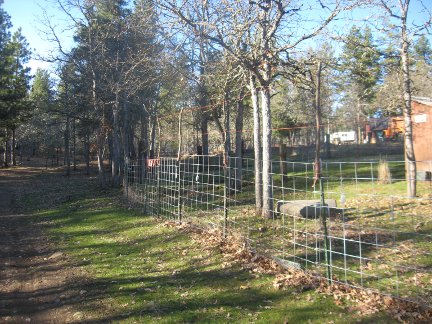Deer Fencing
February 11th, 2011
Lindsay:
Protecting our fruit trees, garden produce and hay from the deer has been a perennial issue. Over the years, the deer seemed to have learned that there is yummy food around here and so they like to keep a close watch on it all and help themselves to it when they feel so inclined. Throughout the property, our primary form of fencing is cattle panel, as it is versatile, durable and does a great job of keeping in/out sheep, goats and cattle. However, the deer hardly consider this 4 1/2 foot fencing a hurdle and just hop right over it to find their way to the tender new growth of an apple tree or the head of a cabbage.
As anyone who has tried to fence in large areas knows, however, the cost of fencing can add up quickly, particularly if you need 7 1/2 -8 foot fencing, which is what is recommended to keep deer out. We looked into a variety of options, from polypropylene "deer fencing" to metal fencing to high tensile wire, and all these options cost between $.50-$1 per foot. The primary area we are looking to enclose has at least a 1/4 mile (1,300 ft) circumference, and every year new growing spaces are created and need to be protected as well. $1000 in additional fencing costs wasn't exactly something we wanted absorb right now, so we decided to go another route.
Baling twine. It is an incredibly useful material, its also cheap, lasts a good long while, and can be used for a variety of purposes. We know one cattle rancher in eastern Oregon who said jokingly that his whole homestead is held together with the stuff. Essentially, the idea is to increase the effective height of the already in place cattle panels by 3-4 feet by extending baling twine between posts, similarly in concept to high tensile wire. Two lines of baling twine about 2 feet apart should create enough height to make the deer think twice about jumping over.
a section of the baling twine fence
the newest attempt to keep deer out
 |
| |
Throughout the fall while thinning in the forest, I cut up straight branches into sections about 4 feet long, which have since been tied to the T-posts that keep the cattle panel in place. We then wrapped the baling twine around and between the forest grown T-posts extenders, and voila, deer fencing. It costs about 1/2 cent per linear foot‒a much more reasonable price point. We'll see what the deer think of it all. And certainly with the nifty control computer device Ruben has been working on (which will be posted soon) the deer may not think our home so inviting anymore.
baling twine stretched between the posts
of the hay barn
 |
| |
Notes From Windward - Index - Vol. 71
|
|